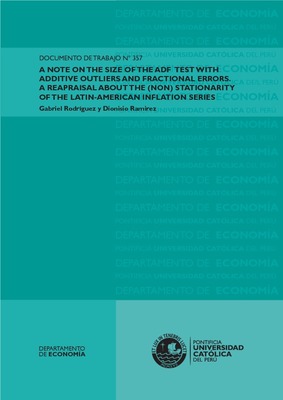| dc.contributor.author | Rodríguez, Gabriel | |
| dc.contributor.author | Ramírez, Dionisio | |
| dc.date.accessioned | 2015-03-19T20:37:55Z | |
| dc.date.available | 2015-03-19T20:37:55Z | |
| dc.date.issued | 2013 | |
| dc.identifier.uri | http://repositorio.pucp.edu.pe/index/handle/123456789/46997 | |
| dc.description.abstract | En esta nota se analiza el tamaño empírico del estadístico Dickey y Fuller aumentado (ADF), propuesto por Perron y Rodríguez (2003), cuando los errores son fraccionales. Este estadístico se basa en un procedimiento de búsqueda de valores atípicos aditivos basado en las primeras diferencias de los datos denominado tau(d). Las simulaciones muestran que el tamaño empírico del estadístico ADF no es afectado por los errores fraccionales confirmando el argumento de Perron y Rodríguez (2003) que el procedimiento tau(d) es robusto a las desviaciones del marco de raíz unitaria. En particular, los resultados muestran una baja sensibilidad del tamaño del estadístico ADF respecto al parámetro fraccional (d). Sin embargo, como es de esperar, cuando hay una fuerte autocorrelación negativa de tipo promedio móvil o autocorrelación autorregresiva negativa, el estadístico ADF tiene un tamaño exacto mayor que el nominal. Estas dificultades desaparecen cuando aumenta la muestra (a partir de T = 100 a T = 200). La aplicación empírica a ocho series de inflación latinoamericana trimestral proporciona evidencia de la importancia de tener en cuenta las variables ficticias para controlar por los outliers aditivos detectados. | es_ES |
| dc.description.abstract | This note analyzes the empirical size of the augmented Dickey and Fuller (ADF) statistic proposed by Perron and Rodríguez (2003) when the errors are fractional. This ADF is based on a searching procedure for additive outliers based on first-differences of the data named tau(d). Simulations show that empirical size of the ADF is not affected by fractional errors confirming the claim of Perron and Rodríguez (2003) that the procedure tau(d) is robust to departures of the unit root framework. In particular the results show low sensitivity of the size of the ADF statistic respect to the fractional parameter (d). However, as expected, when there is strong negative moving average autocorrelation or negative autoregressive autocorrelation, the ADF statistic is oversized. These difficulties are fixed when sample increases (from T = 100 to T = 200). Empirical application to eight quarterly Latin-American inflation series is also provided showing the importance of taking into account dummy variables for the detected additive outliers. | en_US |
| dc.language.iso | spa | es_ES |
| dc.publisher | Pontificia Universidad Católica del Perú. Departamento de Economía | es_ES |
| dc.relation.ispartof | urn:issn:2079-8466 | |
| dc.relation.ispartof | urn:issn:2079-8474 | |
| dc.relation.ispartofseries | Documento de Trabajo;357 | es_ES |
| dc.rights | Atribución-NoComercial-SinDerivadas 2.5 Perú | * |
| dc.rights | info:eu-repo/semantics/openAccess | es_ES |
| dc.rights.uri | http://creativecommons.org/licenses/by-nc-nd/2.5/pe/ | es_ES |
| dc.subject | Outliers aditivos | es_ES |
| dc.subject | Errores ARFIMA | es_ES |
| dc.subject | Test ADF | es_ES |
| dc.title | A Note on the Size of the ADF Test with Additive Outliers and Fractional Errors. A Reapraisal about the (non) stationarity of the Latin-American Inflation Series | es_ES |
| dc.title.alternative | Una Nota sobre el Tamaño del Test ADF con Observaciones Atípicas Aditivas y Errores Fraccionales: Una Re-Evaluación de la (no) Estacionariedad de las Series de Inflación en América Latina | es_ES |
| dc.type | info:eu-repo/semantics/workingPaper | |
| dc.type.other | Documento de trabajo | |
| dc.subject.ocde | http://purl.org/pe-repo/ocde/ford#5.02.00 | |
| dc.publisher.country | PE | |
| renati.advisor.orcid | https://orcid.org/0000-0003-1174-9642 | |


